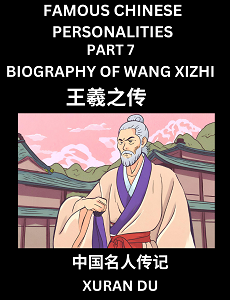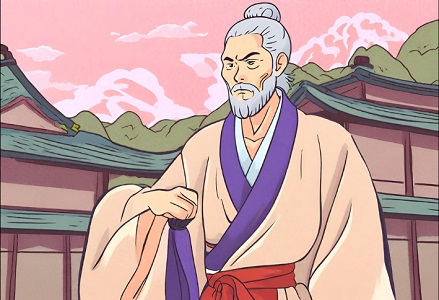Title of Biography in Chinese, Pinyin: 王羲之传 (Wángxīzhī Zhuàn).

Title of Biography in English: The Biography of Wang Xizhi.
Check out books on my Amazon and Barnes & Noble homepages as well as the following pages to learn Biographies of famous Chinese personalities-
- Part 1 – Chinese Biography Book Series for Beginners
- Part 2 – Chinese Biography Book Series for Beginners
- Part 3 – Chinese Biography Book Series for Beginners

The Biography of Wang Xizhi in English (英文传记)
Wang Xizhi: The Master of Calligraphy, Forever Revered
Wang Xizhi, also known as Yishao, was a renowned calligrapher of the Eastern Jin Dynasty, widely regarded as the “Sage of Calligraphy.” He was born into the prestigious Langya Wang clan and received a sound education from a young age. Not only was he exceptionally talented, but he was also diligent and eager to learn, developing a profound interest in the art of calligraphy.

Wang Xizhi’s mastery of calligraphy was profound, encompassing the regular script, running script, and cursive script, all at a remarkably high level. His calligraphic works are renowned for their natural fluidity and elegant elegance, earning him widespread praise from later generations. His masterpiece, the “Lanting Xu,” is considered a pinnacle of Chinese calligraphy and has been handed down through the ages.
In addition to his mastery of calligraphy, Wang Xizhi was also a literati and an official. His literary works demonstrate profound literary skills and a unique artistic style. Politically, he served as the Right Army General and the Governor of Kuàijī, making contributions to the stability and development of the Eastern Jin court.
However, Wang Xizhi encountered numerous challenges and hardships in his later life. Due to intense political struggles and the decline of his family’s influence, he gradually lost his former status and power. Nonetheless, he maintained his noble character and unwavering convictions, continuing to explore and innovate in the art of calligraphy.

Eventually, Wang Xizhi passed away in Kuàijī (now Shaoxing, Zhejiang Province), at the age of seventy-six. His life was filled with legendary color, leaving behind a precious cultural legacy and spiritual wealth for later generations.
Learn Biography Of Wang Xizhi in Chinese (王羲之的详细传记)
王羲之,字逸少,东晋时期著名的书法家,被誉为“书圣”。他出身于琅琊王氏,家族显赫,自幼便受到良好的教育。王羲之不仅才华横溢,而且勤奋好学,对书法艺术有着浓厚的兴趣。

王羲之的书法造诣极深,他的楷书、行书、草书均达到了极高的水平。他的书法作品以自然流畅、飘逸洒脱著称,深受后世赞誉。王羲之的代表作《兰亭序》更是被誉为中国书法艺术的巅峰之作,流传千古。
除了书法艺术外,王羲之还是一位文学家和官员。他的诗文作品同样表现出深厚的文学功底和独特的艺术风格。在政治上,他也曾官至右军将军、会稽内史,对东晋朝廷的稳固和发展做出了一定的贡献。
然而,王羲之晚年遭遇了不少挫折和磨难。由于政治斗争的激烈和家族势力的衰落,他逐渐失去了昔日的地位和权势。尽管如此,他仍然保持着高尚的情操和坚定的信念,在书法艺术上继续探索和创新。
最终,王羲之在会稽(今浙江绍兴)病逝,享年七十六岁。他的一生充满了传奇色彩,为后世留下了宝贵的文化遗产和精神财富。
Wang Xizhi Biography Keywords- English, Chinese & Pinyin (关键词)

- 王羲之(Wángxīzhī, Wang Xizhi): A renowned calligrapher of the Eastern Jin Dynasty, known as the “Sage of Calligraphy.”
- 书法(Shūfǎ): The art of writing Chinese characters as a form of calligraphy.
- 兰亭序(Lántíng Xù): A famous calligraphy work by Wang Xizhi, considered a peak in Chinese calligraphy.
- 会稽(Kuàijī): An ancient place name, now known as Shaoxing in Zhejiang Province, where Wang Xizhi passed away.
Pinyin of Wang Xizhi Biography (王羲之传记的拼音)

Wángxīzhī, zì yì shǎo, dōngjìn shíqí zhùmíng de shūfǎ jiā, bèi yù wèi “shū shèng”. Tā chūshēn yú lángyá wáng shì, jiāzú xiǎnhè, zì yòu biàn shòudào liánghǎo de jiàoyù. Wángxīzhī bùjǐn cáihuáhéngyì, érqiě qínfèn hàoxué, duì shūfǎ yìshù yǒuzhe nónghòu de xìngqù.
Wángxīzhī dì shūfǎ zàoyì jí shēn, tā de kǎishū, hángshū, cǎoshū jūn dádàole jí gāo de shuǐpíng. Tā de shūfǎ zuòpǐn yǐ zìrán liúchàng, piāoyì sǎtuōzhe chēng, shēn shòu hòushì zànyù. Wángxīzhī dì dàibiǎozuò “lántíng xù” gèng shì bèi yù wéi zhōngguó shūfǎ yìshù de diānfēng zhī zuò, liúchuán qiāngǔ.
Chúle shūfǎ yìshù wài, wángxīzhī háishì yī wèi wénxué jiā hé guānyuán. Tā de shī wén zuòpǐn tóngyàng biǎoxiàn chū shēnhòu de wénxué gōngdǐ hé dútè de yìshù fēnggé. Zài zhèngzhì shàng, tā yě céng guān zhì yòu jūn jiāngjūn, guìjī nèi shǐ, duì dōngjìn cháotíng de wěngù hé fāzhǎn zuò chūle yīdìng de gòngxiàn.
Rán’ér, wángxīzhī wǎnnián zāo yù liǎo bù shǎo cuòzhé hé mónàn. Yóuyú zhèngzhì dòuzhēng de jīliè hé jiāzú shìlì de shuāiluò, tā zhújiàn shīqùle xīrì dì dìwèi hé quánshì. Jǐnguǎn rúcǐ, tā réngrán bǎochízhe gāoshàng de qíngcāo hé jiāndìng de xìnniàn, zài shūfǎ yìshù shàng jìxù tànsuǒ hé chuàngxīn.

Zuìzhōng, wángxīzhī zài guìjī (jīn zhèjiāng shàoxīng) bìngshì, xiǎngnián qīshíliù suì. Tā de yīshēng chōngmǎnle chuánqí sècǎi, wèi hòushì liú xiàle bǎoguì de wénhuà yíchǎn hé jīngshén cáifù.